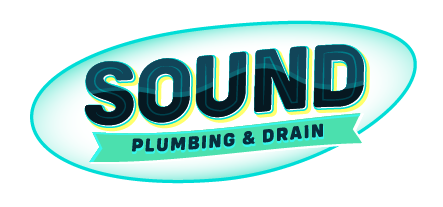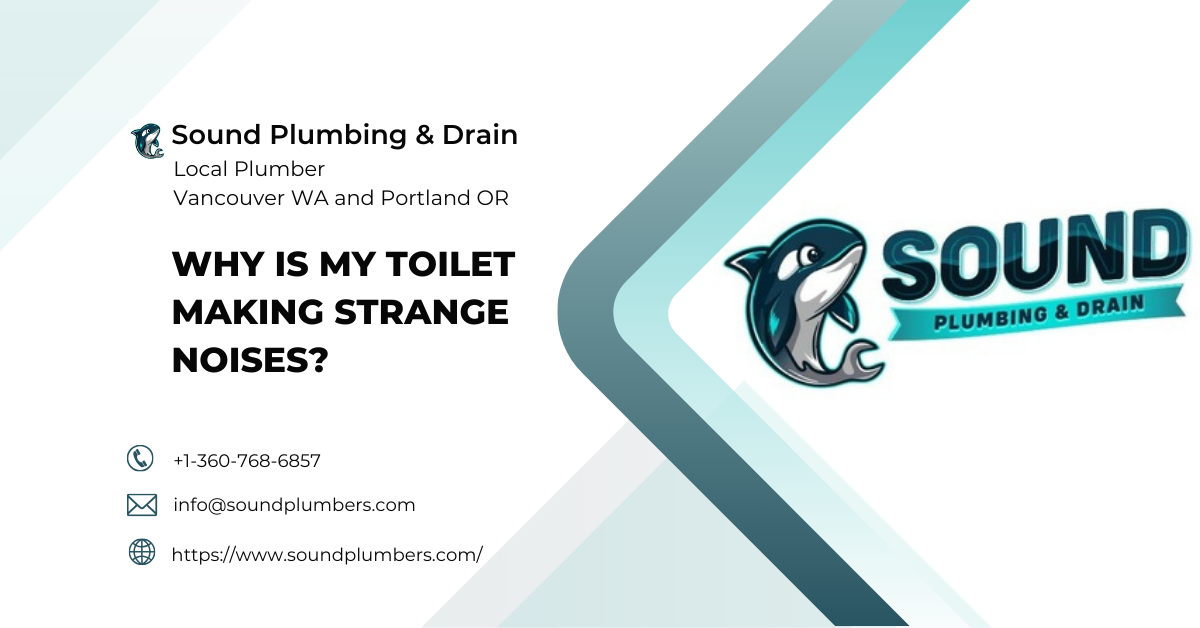Why is my toilet making strange noises and what can I do about it?
Strange toilet sounds like hissing, gurgling, phantom flushing, or loud thumps can signal specific plumbing issues that require attention. Whether it’s a faulty fill valve, high water pressure, or a blocked drain or vent stack, recognizing the cause is the first step toward a lasting solution. Timely toilet repair can save water, reduce utility bills, and prevent structural damage. This guide provides expert-backed explanations and recommended repairs from Sound Plumbing & Drain, serving homes across Portland, Oregon and Vancouver, Washington.
Here's What We Have Covered In This Article
Common Toilet Noises and What They Mean
Hissing Sound After Flushing
A continuous hissing noise after a flush usually points to a faulty fill valve or high water pressure. Sediment buildup inside the valve can also obstruct proper functioning. Use a pressure gauge to test water pressure and consider replacing the fill valve with a model like the Fluidmaster 400H. This type of fix often falls under standard toilet fill valve replacement.
Gurgling or Bubbling Noise
These sounds may come from the toilet bowl, even when the toilet is not in use. Gurgling often means a partially clogged drain line or a blocked plumbing vent stack. This causes negative pressure, pulling air through the toilet trap. Use a plunger or auger to clear minor blockages, but deeper obstructions require a drain line inspection from a professional plumber.
Foghorn or Moaning Noise
A deep, vibrating noise resembling a foghorn is generally caused by a loose washer or aging float valve in older toilets. Replacing the ballcock-style valve with a newer fill valve design typically eliminates the problem.
Phantom Flushing
This phenomenon occurs when the toilet tank periodically refills without anyone flushing. It usually indicates a slow leak from the tank to the bowl due to a deteriorated flapper or flush valve seal. Fluidmaster’s 502 flapper or the convertible 523A Super Flapper are suitable replacements depending on your toilet’s flush valve size.
Whistling or Squealing Noise
High-pitched noises that occur during refilling can point to sediment buildup or wear in the fill valve. Cleaning the valve’s internal parts or replacing it can resolve the issue. If water pressure is above 80 psi, a pressure-reducing valve should be installed.
Loud Banging (Water Hammer)
Water hammer is a hydraulic shock that happens when water flow is suddenly halted, causing pipes to bang. This is common in homes lacking air chambers or with poorly secured piping. Water hammer arrestors or pressurized air chambers can help reduce these noises. High water velocity from toilets with fast fill rates can also contribute.
Trickling or Running Water
If you hear continuous running water, the issue often lies with the flapper valve not sealing properly, or the float being set too high. Replace worn-out flappers or adjust the float level to prevent water from overflowing into the overflow tube. Also check that the fill tube is properly positioned and not preventing the tank from filling to the correct level.
Vibrating Toilet After Flushing
Toilets that vibrate after flushing may have loose fill valve components or unstable mounting inside the tank. These vibrations can amplify through the floor and walls, especially in older homes. Replace any worn parts and ensure all fasteners are tight.
Water Resonance or Humming
A constant humming or thrumming noise during refilling can result from resonance within the supply valve or shut-off valve. In these cases, using a regulated fill valve like Fluidmaster’s 400AH PerforMAX valve often reduces vibration and sound.
Clunking or Thumping After Flush
Sudden clunking noises usually trace back to a faulty stop valve or a failing check valve. These are designed to control water direction and pressure. Replacement is typically straightforward for a licensed plumber.
Other Problems That Cause Toilet Noise or Trouble
Low Water in the Toilet Bowl
If the water level in your toilet bowl looks low, it might be caused by a misaligned or broken fill tube, or clogged inlet holes under the rim. Position the fill tube so that it directs water into the overflow tube, and clean rim holes using vinegar and a small wire.
No Water in the Tank
If the tank doesn’t refill after flushing, first make sure the shut-off valve is open. Then inspect the water supply line for leaks or blockages. A damaged or worn fill valve might need to be replaced.
Loose or Stuck Toilet Handle
A loose handle can prevent proper flushing. Tighten or replace the mounting nut inside the tank, and make sure the lift chain has enough slack to pull the flapper up when you flush. If the handle is corroded or cracked, replace it entirely.
Leaks Around the Base or Tank
Leaks at the base of the toilet often point to a failed wax ring. Tank leaks could mean the bolts or gasket between the tank and bowl need replacing. These types of repairs often involve draining the tank and removing it from the bowl.
Persistent Clogs or Overflows
Most minor clogs can be handled with a plunger. If that doesn’t work, try a toilet auger or enzymatic cleaner. Avoid chemical drain openers which can damage pipes and toilet parts. If all else fails, call a plumber.
Determine Your Toilet Type Before Repair
Not all toilets are built the same. One of the most important steps before you try to fix any issue is figuring out what kind of flush valve your toilet has. Most older toilets use a 2-inch valve, while newer or high-efficiency models often use a 3-inch valve. This matters because the replacement parts, especially flappers, need to match the size of the flush valve opening in your tank.
If you’re not sure what size you have, lift the tank lid and take a quick look. A 3-inch valve usually looks noticeably wider than a 2-inch one. Fluidmaster even offers an easy sizing guide if you want help figuring it out. Getting this part right will save you from repeat problems down the road.
DIY Repairs vs. Professional Plumbing Service
Some toilet sounds are simple fixes that you can handle with a few basic tools and a little patience. If you’ve got a hissing toilet, for example, it might just need a new fill valve or a quick adjustment to the float. A flapper that’s not sealing properly is another common repair that many homeowners can tackle.
But there are times when it’s safer and more effective to call a plumber. If your toilet is making loud banging noises, vibrating through the floor, or flushing by itself in the middle of the night, it’s a good idea to have it checked out by a professional. These issues often point to problems deeper in your plumbing system or worn parts that require a more involved fix.
Sound Plumbing & Drain helps homeowners across Vancouver WA and Portland OR with all kinds of toilet issues, from small repairs to full replacements. If you’re not sure what’s going on, we’ll get to the bottom of it quickly. We specialize in plumbing services in Vancouver WA, including fixture repairs, leak detection, and full toilet replacements.
Regional Plumbing Factors: Portland and Vancouver
Toilets in the Pacific Northwest face a few unique challenges. Homes in this area often deal with hard water, which means minerals like calcium and magnesium can build up inside your plumbing and toilet components. Over time, this buildup wears out parts faster and affects how well your toilet runs.
Also, many houses in the Portland and Vancouver areas still have older plumbing systems, especially in neighborhoods with mid-century homes. These systems are more likely to experience issues like water hammer, pipe vibration, and pressure changes that can trigger odd toilet sounds.
It helps to keep up with regular maintenance, especially if your home has galvanized pipes or your water has a higher mineral content. Swapping out older parts for updated ones, like Fluidmaster’s newer fill valves or flappers, can make a big difference.
Recommended Repair Kits and Parts
If you’re tackling a repair yourself or preparing for a professional visit, it helps to know what parts to have on hand. Over time, toilet parts wear out, especially if you’re dealing with high water pressure or mineral-rich water like we have in Portland and Vancouver.
Here are a few solid options we regularly recommend:
-
Fluidmaster 502 flapper – This works for toilets with a 2-inch flush valve, which is common in older models.
-
Fluidmaster 5403 or 523A – These are reliable picks for newer toilets with a 3-inch flush valve.
-
Fluidmaster 400H or 400AH fill valves – These models offer quiet operation and help prevent noise issues caused by high water flow or worn valves.
-
Fluidmaster Everything Kits – These kits come with everything you need if you’re replacing multiple parts in one go. They’re handy for a full tank rebuild and save you from running back to the store for missing parts.
We recommend sticking with trusted brands that are built to last. The right part not only solves the noise issue but also helps your toilet run more efficiently in the long run.
When to Call Sound Plumbing & Drain
Sometimes a toilet noise seems small at first, but it can be a sign of something more serious. If you’ve tried adjusting the float or swapping the flapper and the sound keeps coming back, it’s best to get a professional opinion.
We handle a lot of these issues for homeowners across Vancouver WA and Portland OR. From fill valves and flush valves to clogs, high water pressure, or aging shut-off valves, we’ve seen it all. Our team uses diagnostic tools to find the source of the problem and fix it right the first time.
If you’re dealing with ghost flushing at 3 AM, water hammer that rattles your pipes, or a toilet that gurgles when nobody’s around, give us a call. We’re local, experienced, and we’ll show up ready to help.
Frequently Asked Questions About Unusual Toilet Sounds
Why does my toilet keep hissing after flushing? This sound usually means your fill valve isn’t sealing properly, or your home’s water pressure might be too high. Replacing the valve often solves it.
Why is my toilet flushing when no one uses it? That’s what we call ghost flushing. It usually comes from a slow leak in the flapper or flush valve. A new flapper can fix the issue quickly.
How can I stop a foghorn noise when I flush? A moaning or foghorn sound is often caused by a loose washer inside the old fill valve. Replacing the valve typically gets rid of the noise.
What causes gurgling in my toilet? If you hear bubbling or gurgling, it might be a sign that your drain line or vent stack has a partial blockage. If plunging doesn’t help, call a plumber.
What’s the easiest way to fix several toilet issues at once? Use a complete repair kit like Fluidmaster’s Everything Kit. It includes all the main parts so you can fix leaks, noises, and slow refills in one go.
If your toilet’s making sounds it shouldn’t, Sound Plumbing & Drain is here to help. We’re just a phone call away for homes in Portland OR and Vancouver WA.





